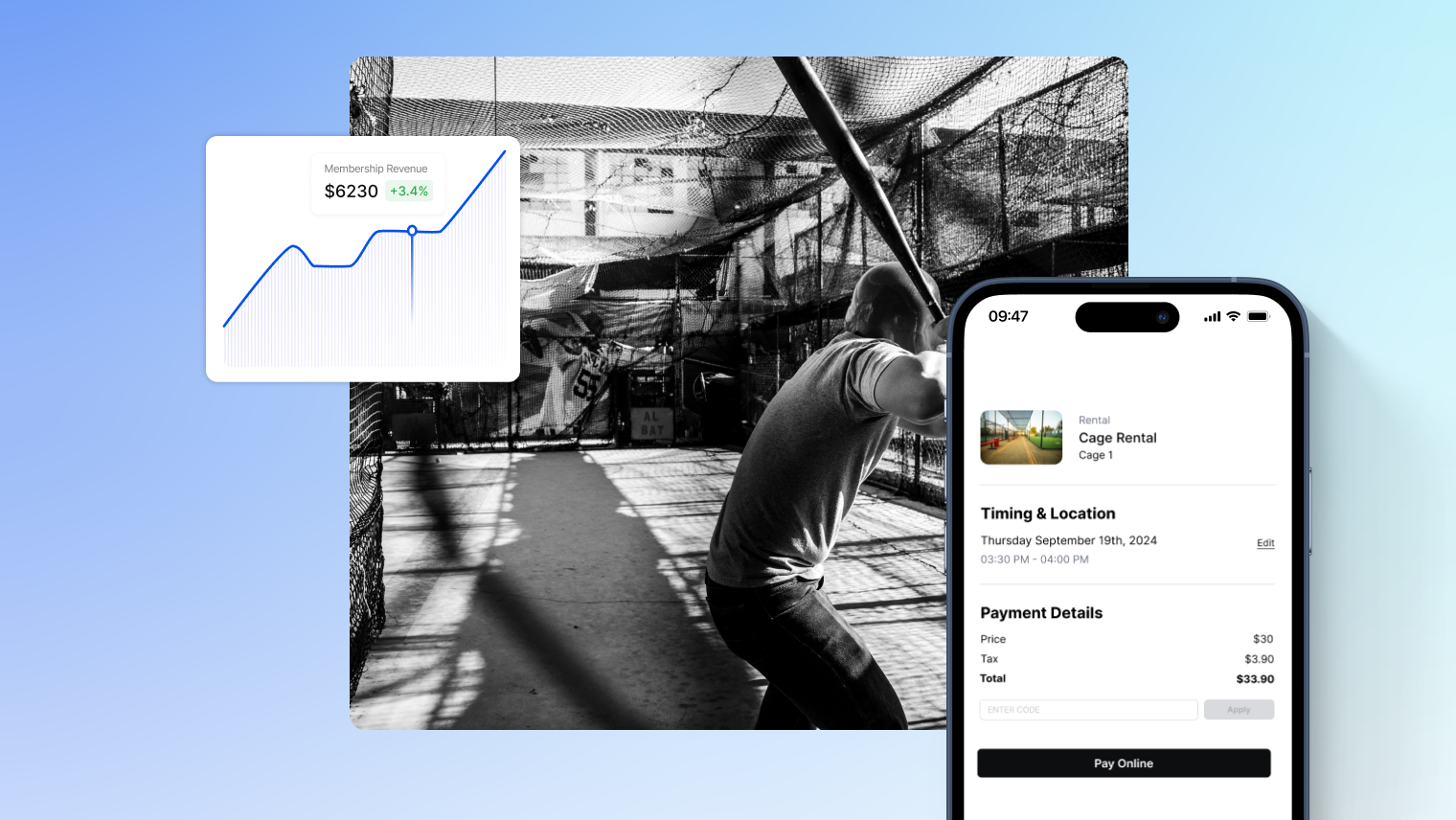Sports facilities are expensive businesses. They require large upfront investment, and significant monthly payments (mostly because of rent). At the same time, they can be very lucrative if done right.
We commonly get questions like “are batting cages profitable?”, “are gun ranges profitable?”, etc. and the answer is always “Yes, but…”. The caveat is that the business needs to be run, from the very beginning, to maximize the profitability of the available space. This is true for all sports - whether it's indoor soccer profitability, batting cages, or maximizing revenue from basketball courts.
Having worked with tons of sports facilities via Swift scheduling software, our team has identified the 5 exact ways in which successful sports facility owners maximize their profitability. Let’s dive in.
#1 - Focus on Revenue per Square Foot
At the end of the day, as the owner of a sports facility - your goal is to maximize revenue per square foot. The cost to build a sports complex is very large, so it's vital that you use your space to the fullest. Regardless of how much space you have, the intent is to figure out how to get more money out of every inch that you do have. Size doesn’t matter! It’s what you do with it that counts.
So how do you do this?
Groups instead of rentals
Rentals, specifically open rentals for the public, are an enticing trap. They look really easy to run, but in the long run - one-off rentals eat into valuable time that you could be offering to larger groups.
Offering public rentals also means you run the risk of exposing your equipment (like a Hittrax machine) and spaces to teenagers and folks that have no experience in the sport. This increases the chances of damage, failure, and maintenance costs.
Remember, the goal is to maximize revenue per square foot. One of the main ways to do this is to focus on larger group sizes (whether that’s teams for rentals, or lessons and classes for instructor-based training), as opposed to random public rentals. Everyone will say they want it, but turnout tends to be poorer, and not worth the overhead.
Recurring revenue instead of one-off
The golden egg for any business owner (not just sports facilities) is recurring revenue. Especially given how seasonal the sports facility business is, profitability and revenue can vary drastically if all your revenue sources are ad-hoc.
To get recurring revenue - offer monthly memberships for serious high school, college, semi-pro, and pro athletes. You can even offer multiple tiers of memberships, with varying discounts. Offer valuable discounts and services to members, things like:
- Unlimited access to spaces when they’re not in use by teams
- 10-20% discounts on private lessons or classes
- 10% discount on retail equipment, etc
Instead of tracking membership payments manually or cash, use a sports facility management software like Swift that automatically tracks members, their discounts and credits, and regularly charges their credit cards.
Another service you can offer is camps & clinics that run across multiple weeks. This isn’t “recurring” in the traditional sense, but it does make up for the cost of using your space over multiple weeks.
Consider starting your own traveling team or sports organization. Having kids play under your brand can be great for branding, as well as open up another source of recurring revenue.
Together, these tactics can be a great way to diversify your income sources and avoid the downsides of low season.
Large invoices instead of small invoices
Similar to the theme above, to optimize your profitability you need to gather larger invoices instead of smaller, one-off payments from the general public.
This means signing contracts with traveling teams, clubs, and organizations that are looking for a space to practice in. These long-term contracts are generally the most lucrative sources of revenue for any sports complex, and they’re a key investment.
Retail
Finally, consider opening up a retail store inside your facility for equipment.
I wouldn’t suggest this for folks starting out (unless you have a large amount of capital you’re willing to invest) - but as you grow, retail equipment can be another great source of income that helps optimize revenue per square foot & eventually, the profitability of your sports facility.
#2 - Multiple uses for large spaces
Your space is your biggest asset, and your biggest liability. To ensure that it appears “in the green '' when you do your finances, it’s important to use the space to it’s fullest.
Open up larger spaces to the public for things like birthday parties (this is especially great if you have an affiliated kids or junior organization), corporate events, and other gatherings. These seem irrelevant, but you’d be surprised at how often these services get booked at nearby sports facilities. Rentals of this kind can also help fill your calendar and maximize revenue potential in off-peak hours.
Talk to your neighbors (neighboring businesses), and offer them the space for a discount if they’re looking to host an event. We’ve seen everything from coffee tastings to protein powder launches done at sports facilities, and this is done in partnership with nearby businesses.
If you have basketball courts, volleyball courts, or indoor soccer courts - recognize that with some new paint lines, you can open up your facility to a whole new sport! With a full gymnasium, you should definitely be offering your facility to as many sports as possible - and all you need to do is paint the court lines accordingly.
Managing spaces for multiple uses like this can be hard to do manually, but modern scheduling software like Swift can easily account for this - making your life easier, and avoiding double-bookings for different services.
#3 - Understand seasonality & plan your finances accordingly
The indoor sports business is highly seasonal. If you live in a city with regular winters (or super hot summers), those are usually your most profitable months. When the weather is nice, athletes and kids everywhere will play outside. This is natural, so instead of trying to fight it - you need to plan around it.
As a rule of thumb, 70-80% of your annual revenue will come in the 3-5 months of “poor” weather (whatever that means for your location - either snowy winters, or ultra hot summers). This means that during low season, you’ll need cash reserves to continue to pay rent, pay your staff, and generally keep the lights on.
Even if you don’t think of yourself as a “mathy” person, it’s important to do this planning upfront to avoid any potential downsides during the lower months. And hopefully, if you’ve been following the steps above, your “low season” shouldn’t actually be that low!
#4 - Automate your facility
One of the biggest life-improvements you can have when managing your sports facility is freeing up your time.
Doing any of the improvements suggested above takes time, and if your time (and energy) is currently spent on the phone fielding calls and messages from customers, you won’t be able to actually grow your business and maximize profitability.
How can you automate your facility?
- Use a modern sports facility management software like Swift to allow your customers to book online. In contrast to traditional tools like eSoft Planner or EZFacility, Swift is meant for mobile (which means your customers will actually book online) and it requires no training for you and your staff. As a bonus, you’ll also get all the other benefits of using a modern scheduling software
- Hire a front-desk person to field the remaining calls. This will eat into your margins (and your profits), but if you’re using the right scheduling tool, you’ll find that the number of calls that you’re receiving will significantly decrease. For any other calls, you can hire part-time high school students to help you out
- Invest in things like automatic door locks, video cameras, etc. to give members off-hours access. This will free up facility space during peak hours, which you can then rent to larger groups to further maximize facility profits.
#5 - Invest in high-tech to differentiate
In business, a common mode of advice is “differentiate or die”. While sports facilities might not be as competitive as the corporate world - it’s still an important message. There needs to be reasons why athletes, instructors, and customers will train at your facility instead of the other one down the road.
You can invest in technologies like high-speed cameras to offer slow-motion footage to your athletes (and charge for this from the public!). You can use athlete management software (Pelotero is a good example of this in baseball) to help instructors track the training and performance of their athletes. You can bring in trained therapists, performance coaches, and trainers to hold weekly “seminars” for semi-pro and professional athletes.
A final word
Owning a sports complex is hard, but it can be a really rewarding business (both financially and otherwise) if you do it well! There's a lot of money in sports, and fulfillment - you just need to be intentional about your methods.
If you have any questions, or need more advice - feel free to drop me an email at jeet@runswiftapp.com. To take serious strides in maximizing your profits, try Swift and use all the hours you’ll save from fielding phone calls in growing your business. Good luck!













